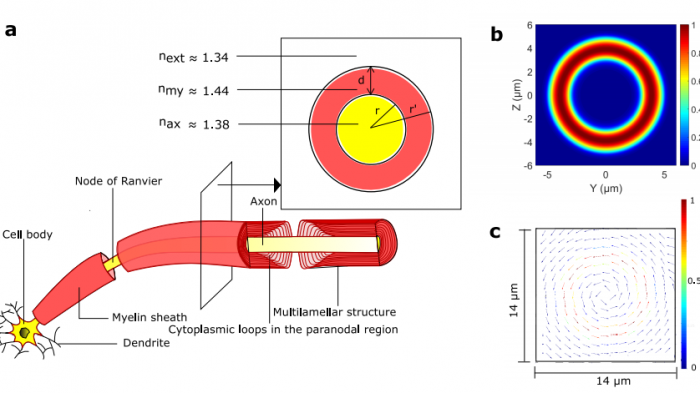Are There Optical Communication Channels in Our Brains?
Here’s an interesting question: are there optical communication channels in the brain? This may be a radical suggestion but one for which there is more than a little evidence to think it is worth pursuing.
Many organisms produce light to communicate, to attract mates, and so on. Twenty years ago, biologists discovered that rat brains also produce photons in certain circumstances. The light is weak and hard to detect, but neuroscientists were surprised to find it at all.
Since then, the evidence has grown. So-called biophotons seem to be produced naturally in the brain and elsewhere by the decay of certain electronically excited molecular species. Mammalian brains produce biophotons with wavelength of between 200 and 1,300 nanometers—in other words, from near infrared to ultraviolet.

If cells in the brain naturally produce biophotons, it’s natural to ask whether nature may have taken advantage of this process to transmit information. For that to happen, the photons must be transmitted from one place to another, and that requires some kind of waveguide, like an optical fiber. So what biological structure could perform that function?
Today we get an answer of sort thanks to the work of Parisa Zarkeshian at the University of Calgary in Canada and a few pals. They've studied the optical characteristics of axons, the long thread-like parts of nerve cells, and conclude that photon transmission over centimeter distances seems entirely feasible inside the brain.
The work is a review of previous experiments and studies of axons. The team first reviewed a study that calculated the optical properties of myelinated axons by solving Maxwell’s famous electromagnetic equations in three-dimensions to determine the cell’s optical properties.
This study suggests that an axon’s outer coating—its myelin sheath—can act as a waveguide to channel biophotons. But it also suggests that a wide range of factors can influence this phenomenon by scattering light or absorbing it.
These factors include how light transmission is affected by bends in the axon, by changes in the radius of the sheath, by non-circular cross sections, and so on.
Zarkeshian and co conclude that axons with lengths of around 2 millimeters—about the length of axons in the brain—could transmit between 46 percent and 96 percent of the biophotons that enter them. “It is worth noting that photons can propagate in either directions: from the axon terminal up to the axon hillock or in the opposite direction along the axon,” they say.
The team goes on to calculate the data communication rates that this allows. Biologists have measured biophotons produced by rat brains at the rate of one photon per neuron per minute. Although that does not sound like many, there are 1011 neurons in a human brain, which suggests it could produce more than a billion photons per second.
“This mechanism appears to be sufficient to facilitate transmission of a large number of bits of information, or even allow the creation of a large amount of quantum entanglement,” say Zarkeshian and co.
Of course, there are numerous uncertainties in these calculations. Nobody knows the precise optical properties of myelin sheaths, for example, because they have never been measured.
The best way to find out more is to test the optical transmission properties of brain tissue. Zarkeshian and co suggest a number of straightforward experiments that would move this field forward. “One way is to light up one end of a thin brain slice and look for the bright spots related to the open ends of the myelinated axons at the other end,” they say. There are various other approaches too. That’s something a neuroscientist with time on his or her hands could take on.
All this points to a bigger conundrum. If our brains have optical communications channels, what are they for? This is a question that is ripe for blue skies speculation.
One line of thought is based on the fact that photons are good carriers of quantum information. Many people have theorized that quantum processes may be behind some of the brain’s more mysterious processes, not least of which is consciousness itself. Zarkeshian and co are clearly enamored with this idea.
But this is no more than wild speculation. Quantum communication requires significantly more than optical communication channels. There must also be mechanisms that can encode, receive, and process quantum information. It is possible that light-sensitive molecules exist in the brain but there is little evidence for this and still less that they serve as quantum processors.
Still, this kind of thinking is exciting and worth pursuing at a basic level. If nature produces biophotons, evolution may well have found a way to exploit them. The question is how.
Ref: arxiv.org/abs/1708.08887: Are There Optical Communication Channels in the Brain?
Deep Dive
Biotechnology and health
How scientists traced a mysterious covid case back to six toilets
When wastewater surveillance turns into a hunt for a single infected individual, the ethics get tricky.
An AI-driven “factory of drugs” claims to have hit a big milestone
Insilico is part of a wave of companies betting on AI as the "next amazing revolution" in biology
The quest to legitimize longevity medicine
Longevity clinics offer a mix of services that largely cater to the wealthy. Now there’s a push to establish their work as a credible medical field.
There is a new most expensive drug in the world. Price tag: $4.25 million
But will the latest gene therapy suffer the curse of the costliest drug?
Stay connected
Get the latest updates from
MIT Technology Review
Discover special offers, top stories, upcoming events, and more.